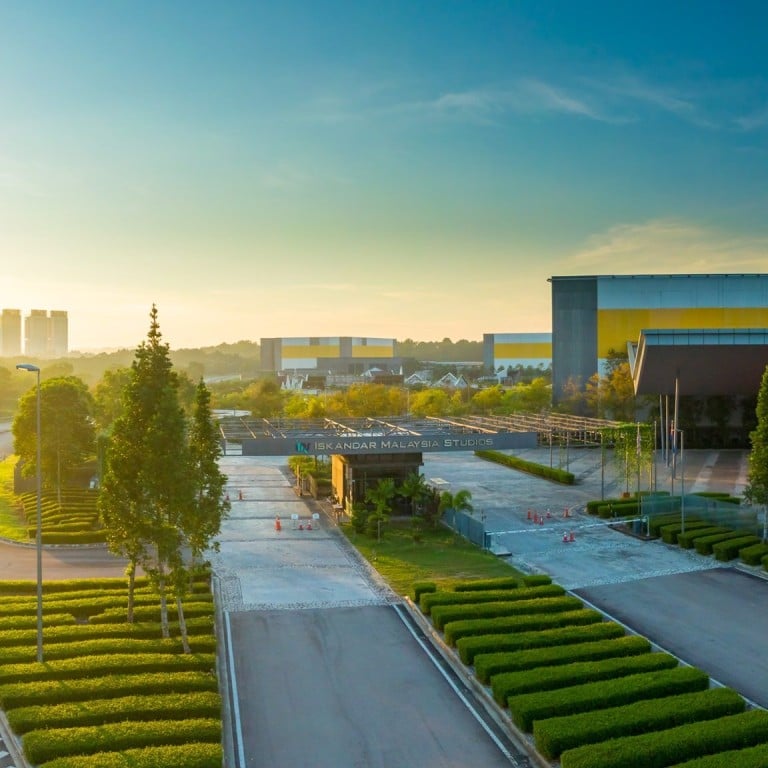
As Malaysia’s Hollywood dreams crumble with Iskandar studios sale, a Singapore firm swoops in
- Malaysia’s sovereign wealth fund sold its stake in Iskandar Malaysia Studios to a Singapore-based media firm for a fraction of its initial investment
- Insiders say the state-of-the-art facilities were hamstrung by their location – and the country’s unhelpful attitudes towards its creative industries
On a visit to the 20-hectare (50-acre) complex a few years after it had opened, local filmmaker Zain Azrai marvelled at the “giant studios” that were “on the same level as the ones in England”.
Pinewood Group, which runs the famed British film and television studios that Zain was referring to, developed the facility in Iskandar Puteri with the Malaysian government’s sovereign wealth fund Khazanah Nasional Berhad.
The studios went on to serve as a set for Netflix’s 2014 historical epic series Marco Polo and portions of the 2017 hit film Crazy Rich Asians, before Pinewood pulled out in 2019 after the complex began struggling to attract productions to use its massive facilities.

“The infrastructure was amazing,” Zain said while recounting his 2017 tour of the site, which he nevertheless found to be strangely deserted. “They were telling me that the studio was open to the local players, and they have packages that were affordable for the local industry … but the thing is, for some reason, they didn’t market it.”
Iskandar Malaysia Studios, as the facility that’s perched near the southernmost edge of the Malaysian peninsula became known after its 2019 rebrand, then proceeded to quietly slip out of a pandemic-distracted public’s consciousness. Until, that is, it emerged this month that Khazanah Nasional Berhad was selling its entire stake for scarcely 10 per cent of what was invested.
The fire sale not only triggered Malaysia’s long-standing rivalry with its rich neighbour, it carried echoes of Khazanah’s 2020 sell-off of its stake in the loss-making children’s edutainment theme park KidZania to a Singaporean company for 3.8 million ringgit (US$860,00).
Why Malaysian-Chinese filmmakers find success in China
By the close of last financial year, the park on the outskirts of Kuala Lumpur – which never made any money under its former management – had brought in 6.46 million ringgit in profits for its new owners.
Jalil Rasheed, former group CEO of the huge Berjaya Corporation conglomerate, quipped on Twitter that Iskandar Malaysia Studios would now similarly be revived and “turned into a powerhouse” by a Singapore company. “We have seen this all too often,” he said.
‘Vanity project’
As late as February last year, then-communications minister Annuar Musa was quoted by local media praising the studios’ “state-of-the-art film facilities”, telling reporters during a tour “we should promote it aggressively to attract foreign filmmakers”.
“We have to think out of the box now … We will encourage members of the global creative industry to work in [these] world-class studios,” he was cited as saying, reflecting official ambitions of making content production into a moneymaking venture for Malaysia’s oil-dependent economy.
Khazanah Nasional said in a statement on April 9 that it was washing its hands of the Iskandar studios as the new owners were a “leading diversified group within Asia’s media and entertainment industry” that had “better capacity to attract large productions”, which in turn would lead to “positive economic spillover benefits on the social economy”.
I think Khazanah was caught up back then with … the novelty of having film studios in Malaysia
“I think Khazanah was caught up back then with the Iskandar [region] frenzy as well as the novelty of having film studios in Malaysia as perhaps being potentially transformative projects,” said Oh Ei Sun, an analyst and former official in Najib’s administration who described the complex as “a vanity project”.
“But events caught up with the studios and it turned out to be a not-so-rewarding venture.”
Since its earliest days, Malaysia’s film industry has been centred on Kuala Lumpur – some 300km north of the Iskandar studios – where much of the talent and behind-the-scenes crews are located.
“No one [in the industry] lives in JB. No one would ever produce [films] in JB,” said an industry source, referring to Johor Bahru, a linchpin city of the Iskandar Malaysia development corridor.
Malaysia has also gained a reputation internationally for intolerance and censorship with the banning of recent blockbuster films such Thor: Love and Thunder and Lightyear.

Director Khairi Anwar and his crew have already been summoned for police questioning, and will now also have to answer to religious authorities. “Things are still not settled, this is the final hurdle,” he told This Week in Asia.
Anna Har from the Freedom Film Network, a group advocating against censorship, said that arbitrary censorship makes filmmaking in Malaysia a risky investment for producers because of the costs entailed with re-editing a film, or enduring a backlash.
“The desire to censor and the desire to have a thriving film industry are in opposition to each other,” Har said.
Malaysia cuts gay scenes in Elton John biopic, draws fire
Other petty rules stifling creativity cited in a Freedom Film Network report on censorship in Malaysia include a requirement for filmmakers to get pre-approval from the police for any scenes showing policing, and official instructions on depicting landmarks that warn against tarnishing the nation’s image.
A veteran local filmmaker who declined to be named provided an apt comparison for how out-of-place the Iskandar studios seem.
“It’s like buying a Ferrari, but you can only drive it in a neighbourhood with a 20km/h speed limit … in a neighbourhood where no one cares that you drive a Ferrari.”


